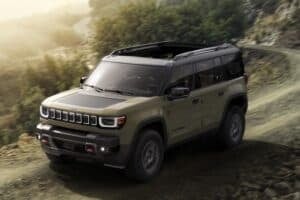Go-Kart experience, complete with fake sound and light show, turns hatch into a toy car.

The new all-electric Mini Cooper SE does an excellent job of living up to the brand’s ethos. Instant torque and enjoyable handling deliver the kind of fun experience the iconic Cooper S 3-door is known for.
While the Mini Cooper SE is a lot bigger and more advanced than its Cooper S Mk1 forefather from the 1960s, there is number that is remarkably similar despite being separated by six decades on their birth certificates. Quite astonishingly, the power to weight ratio difference between the models are only 10kW/ton. The Mini Cooper SE has a power to weight ratio of 98kW/ton compared to the Mk1’s 88kW/ton.
Mini Cooper S an icon
The Mk1 that famously won the Monte Carlo rally in the 1960s before and negotiated drainpipes and stairways in the original The Italian Job film was fitted with a 1 275cc engine kicking out a princely 57kW. But, a kerb weight of only 645kg gave it a very respectable power to weight ratio in a game where 100kW/ton was once the golden benchmark.
The Mini Cooper SE’s outputs of 160kW/330Nm produced by a single electric motor is actually more than its internal combustion sibling’s 150kW/300Nm. But electric cars have a major weakness and that is the weight of its batteries, which in the SE’s case is a 54.2-kWh lithium-ion battery pack. Its kerb weight of 1 620kg therefore stand out like a sore tooth against the petrol engine model’s 1 285kg.
ALSO READ: New Mini Cooper S stays true to peppy and fun ‘hot hatch’ roots
The resulting power to weight ratio of 98kW/ton drags the SE way down from the 116kW/ton ratio of its petrol-powered sibling. This leads right into the other sticky point. The price. The Mini Cooper SE costs R802 000, a R155 605 premium over the R646 395 Cooper S 3-door.

Political shenanigans
In a first world country with zero carbon emission targets, various incentives and subsidies are in place to ensure electric vehicle (EV) ownership is a viable option compared to cars powered by internal combustion engines. But we live at the southern tip of Africa ruled by a government that is likely reading the White Paper on proposed future policies of new energy vehicles upside down.
Until they figure this thing out and relax taxation on EVs, cars like the Mini Cooper SE will stay expensive unfortunately. And even though charging at home will be much cheaper than filling a stank with petrol, you’ll have to drive at least 120 000km before breaking even.
This is a real pity. And by no fault of Mini or its owners BMW, even though GWM builds the electric version in China. The carmaker has come a long way since the days of the BMW i3, which compared the Mini Cooper SE, tragically lacked a soul.
Knockout colour
The SE is a great blend of modern technology with a fair bit of retro-ness which ranges from the driving straight through to the styling. The tester The Citizen Motoring drove in Sunny Side yellow paint with black roof and mirror caps was a real head-turner.
Like the electric-only Mini Aceman, the Cooper SE’s cabin is very simplistic. A variety of hard-wearing recycled fabrics feature all over the cabin clad in all sorts of funky colour combinations.
The 9.4-inch OLED roundel infotainment system which controls most functions takes centre stage on the dashboard. Making up for the absence of an instrument cluster is a head-up display.
What we liked is that there is still physical switchgear for some functions like side mirror adjustments and volume control. A key-like start switch features between a toggle switch gear selector and Experience selector, the latter becoming our go-to plaything.
Go-Kart experience
Instead of run-of-the-mill driving modes, the Experience mode selector allows you choose a mode like Vivid or Green that not only adjusts the driving dynamics, but also the look and feel of the cockpit in terms of screen design and ambient lightning. In our case, the preferred option was the Go-Kart Experience.

Flipping the switch into Go-Kart mode gets Mini Cooper SE as excited as the driver, with a loud “woo hoo!” glaring from the speakers as soon as its activated. It unleashed a lightning quick throttle response, firms up an already stiff suspension and makes the feedback on the torque steering a lot more accentuated for a sportier feel. Better yet, it activates a sound akin to an arcade racing game. At might sound a tad to artificial at first, but once you become addicted it’s hard to disengage Go-Kart.
ALSO READ: Petrol and EV confirmed as BMW prices all-new Mini Cooper
On smooth surfaces with little feedback from the suspension you don’t really notice the SE’s weigh too much. But on less than perfect roads you do get a feeling for the mass you are carrying as the firm suspension starts bouncing around a bit. That, and the fact that we suffered a tyre burst hitting a pothole forced us to abandon any plans of trying to emulate the 1960s icon and drive it down a staircase or two.
Mini Cooper SE passes the test
Like any fossil fuel-driven car, the harder you press the accelerator, the higher the consumption. Going about your business in a civilised manner will ensure power consumption of less than 20kWh which should get you just over 300km of range. But play too hard and you’ll need to stop a lot more for charging. But Mini has made provisions for that too, as the Cooper SE supports DC charging of up to 95kW.
Political shenanigans burdening the Mini Cooper SE aside, the hatch does an excellent job of upkeeping what Mini is within an electric persona. If more soulless electric cars can adopt personalities like this, maybe the future won’t be all that boring.






